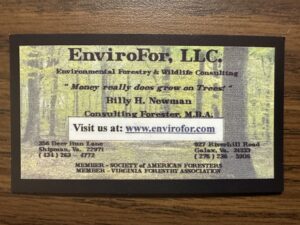Virginia Forest Management
The temperate hardwood forests of the Eastern United States are nothing short of spectacular! We often hear that a forest is this best left alone to develop naturally without human interference. However, forests are dynamic places, ever changing both by natural forces and human activity. How does the forest change?
Forest succession is a natural, inevitable, continuous process through which changes in forest structure, age class, and species composition occur over time. Succession proceeds in stages, but does not remain stable until the final or climax stage.
But first, let’s examine how the climax stage of forest succession is achieved.
An open field is abandoned and before you know it, herbaceous forbs and woody shrubs are replacing grasses. Within a few years the field is gone, being replaced by tree species such as cedar, black locust, wild cherry, pines, and non-native, exotics like tree-of-heaven and paulownia. These are the “pioneer” species because they are the first to arrive on the scene! They are intolerant to shade and must live their life cycle in full sunlight. Primary forest succession has occurred!
After several decades, these species have completed their life cycle and mortality begins to remove them from the forest. Different species of trees have been developing underneath the forest canopy anxiously awaiting sunlight to reach the forest floor. The oaks, hickory, yellow poplar and other species that can tolerate shade early on, but must have full sunlight in order to mature are replacing the pioneer species. These intermediate intolerants will survive several decades to several hundred years depending on specie. But, they too will complete their life cycle and die allowing the trees in the understory to become dominant.
Species that can germinate, grow, and fully develop under shade are now the predominant trees reaching the overstory canopy. The maples, American beech, birches and other shade tolerant species have replaced the oaks, hickory and yellow poplar.
The forest has reached the climax or final stage of forest succession and can now persist in perpetuity or until a disturbance sets succession back to an earlier stage of forest development. The level of disturbance determines the setback.
The practice of forest management applies the basic principle of forest succession to manipulate these natural changes. If a forest landowner desires an oak-hickory forest type, then natural succession must be disrupted in order to develop or maintain the stage conducive to intermediate intolerant tree species. The oaks, hickory, yellow poplar, and pines will not persist otherwise! Mother Nature will assuredly take control
Forest management techniques such as timber harvesting will allow for succession to be directed toward a certain stage depending on the desired goals and objectives of the landowner. The goal in some areas of a forested property may be to allow nature to take her course and not harvest any trees, while an adjacent stand may be clearcut in order to set back succession to the primary stage.
Contact EnviroFor, LLC.
EnviroFor, LLC.
356 Deer Run Lane
Shipman, Virginia 22971
(434) 263-4772
enviroforllc@netscape.net

